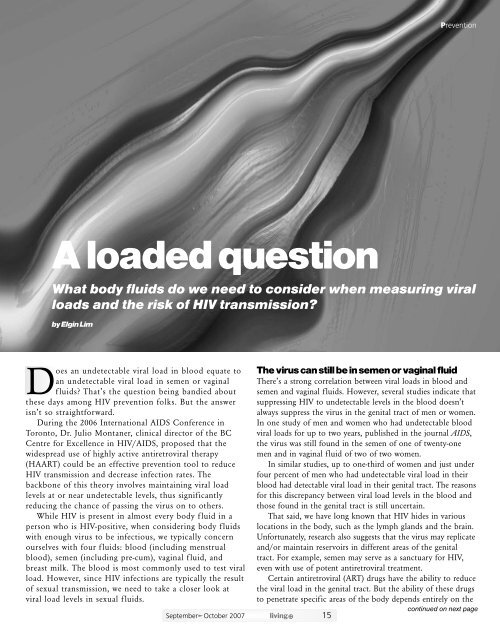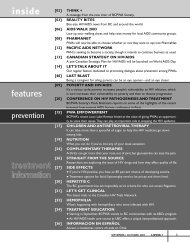iv poz mag.qxd - Positive Living BC
iv poz mag.qxd - Positive Living BC
iv poz mag.qxd - Positive Living BC
You also want an ePaper? Increase the reach of your titles
YUMPU automatically turns print PDFs into web optimized ePapers that Google loves.
issue 50.<strong>qxd</strong>:l<strong>iv</strong> <strong>poz</strong> <strong>mag</strong>.<strong>qxd</strong> 9/3/07 4:04 PM Page 15<br />
Prevention<br />
A loaded question<br />
What body fluids do we need to consider when measuring viral<br />
loads and the risk of HIV transmission?<br />
by Elgin Lim<br />
Does an undetectable viral load in blood equate to<br />
an undetectable viral load in semen or vaginal<br />
f luids? That’s the question being bandied about<br />
these days among HIV prevention folks. But the answer<br />
isn’t so straightforward.<br />
During the 2006 International AIDS Conference in<br />
Toronto, Dr. Julio Montaner, clinical director of the <strong>BC</strong><br />
Centre for Excellence in HIV/AIDS, proposed that the<br />
widespread use of highly act<strong>iv</strong>e antiretroviral therapy<br />
(HAART) could be an effect<strong>iv</strong>e prevention tool to reduce<br />
HIV transmission and decrease infection rates. The<br />
backbone of this theory involves maintaining viral load<br />
levels at or near undetectable levels, thus significantly<br />
reducing the chance of passing the virus on to others.<br />
While HIV is present in almost every body f luid in a<br />
person who is HIV-posit<strong>iv</strong>e, when considering body f luids<br />
with enough virus to be infectious, we typically concern<br />
ourselves with four f luids: blood (including menstrual<br />
blood), semen (including pre-cum), vaginal f luid, and<br />
breast milk. The blood is most commonly used to test viral<br />
load. However, since HIV infections are typically the result<br />
of sexual transmission, we need to take a closer look at<br />
viral load levels in sexual f luids.<br />
SeptemberqOctober 2007 l<strong>iv</strong>ing5 15<br />
The virus can still be in semen or vaginal fluid<br />
There’s a strong correlation between viral loads in blood and<br />
semen and vaginal fluids. However, several studies indicate that<br />
suppressing HIV to undetectable levels in the blood doesn’t<br />
always suppress the virus in the genital tract of men or women.<br />
In one study of men and women who had undetectable blood<br />
viral loads for up to two years, published in the journal AIDS,<br />
the virus was still found in the semen of one of twenty-one<br />
men and in vaginal fluid of two of two women.<br />
In similar studies, up to one-third of women and just under<br />
four percent of men who had undetectable viral load in their<br />
blood had detectable viral load in their genital tract. The reasons<br />
for this discrepancy between viral load levels in the blood and<br />
those found in the genital tract is still uncertain.<br />
That said, we have long known that HIV hides in various<br />
locations in the body, such as the lymph glands and the brain.<br />
Unfortunately, research also suggests that the virus may replicate<br />
and/or maintain reservoirs in different areas of the genital<br />
tract. For example, semen may serve as a sanctuary for HIV,<br />
even with use of potent antiretroviral treatment.<br />
Certain antiretroviral (ART) drugs have the ability to reduce<br />
the viral load in the genital tract. But the ability of these drugs<br />
to penetrate specific areas of the body depends entirely on the<br />
continued on next page











